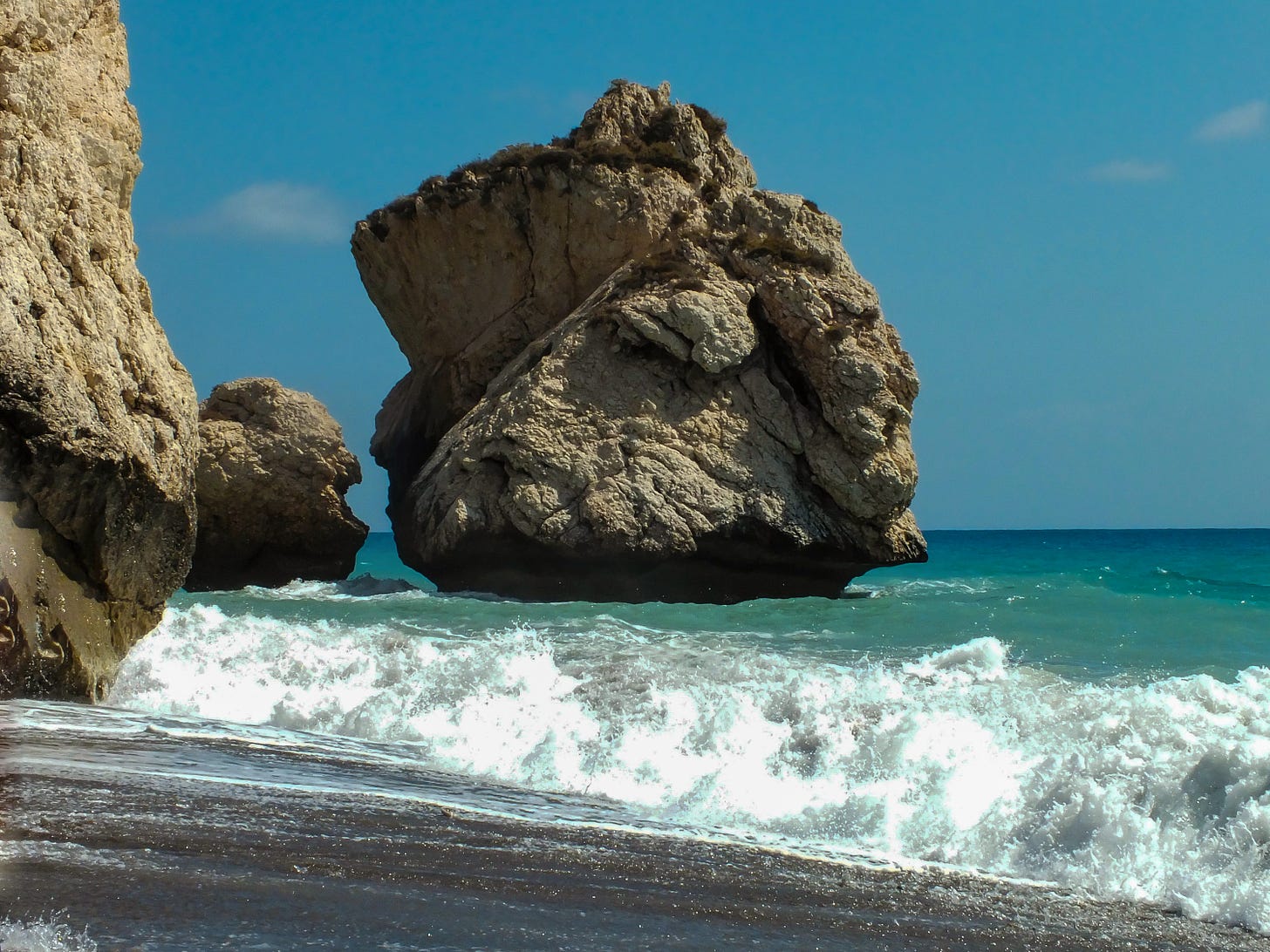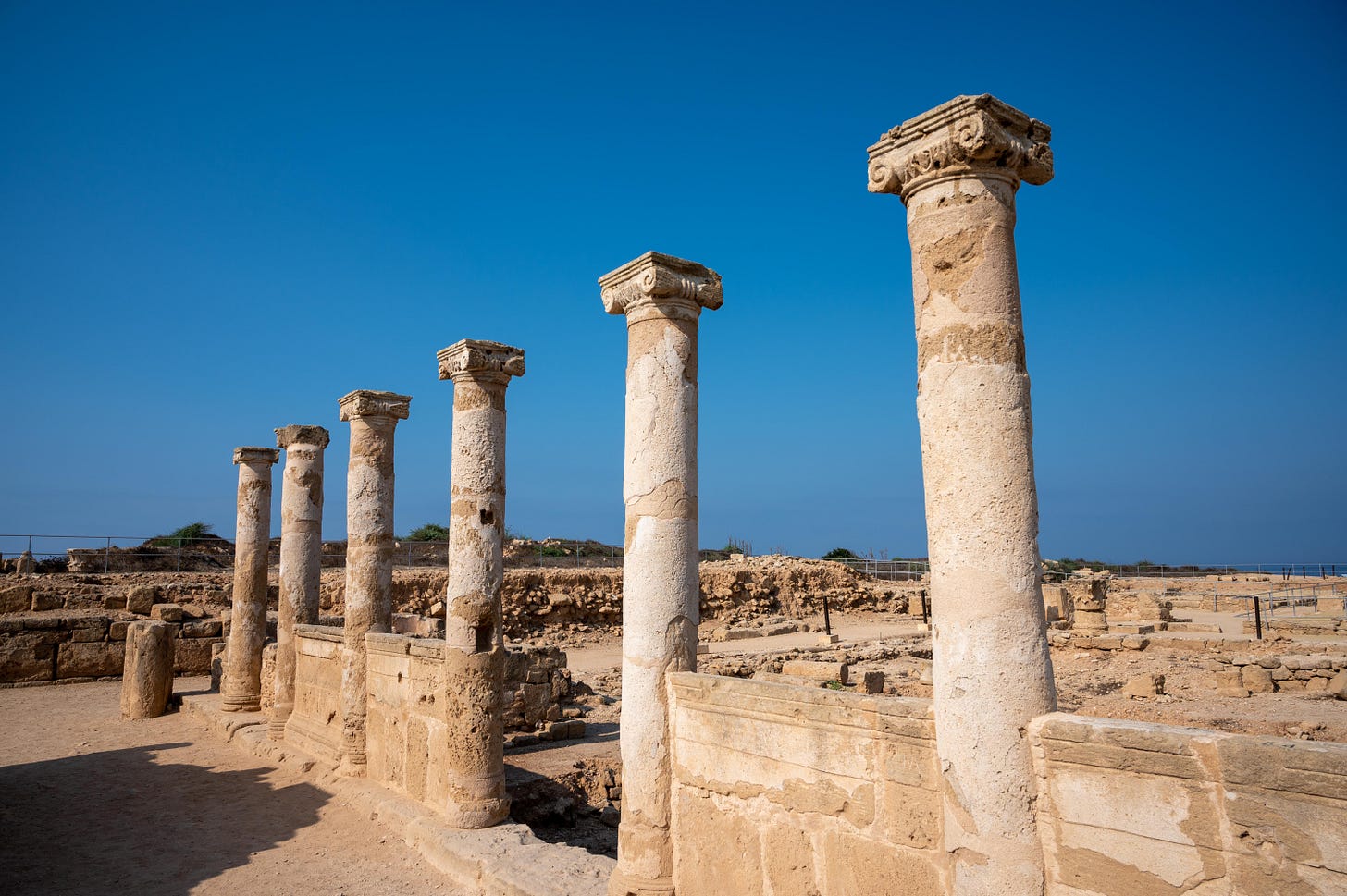Paphos, the Sex Capital of the Ancient World
Paphos, a city in Cyprus was the birthplace of Aphrodite, the Greek goddess of sex and love. The city was known as the sex capital of the ancient world.

The Birthplace of Aphrodite, the Greek Goddess of Sex and Love
Ludolph von Suchem, a German priest and traveler who had spent years traveling in the Holy Land and the Eastern Mediterranean islands, makes a very profound observation about Cyprus that had irked and amused in equal measure several generations of Cypriots.
"The soil of Cyprus provoked men to lust"
The Greek historian Herodotus, writing about Cyprus in the 5th Century BC, also makes similar observations centuries ago when he talks about some weird sex customs that the women of the land must follow.
"The foulest Babylonian custom is that which compels every woman of the land to sit in the temple of Aphrodite and have intercourse with some stranger at least once in her life. It applied to all women high and low. A woman could not refuse payment. Once a stranger had made his choice and cast money into her lap she would be forced to have intercourse outside the temple.”
Ludolf von Sudheim and Herodotus talk about Paphos, a city in Cyprus, the birthplace of Aphrodite, the Greek goddess of sex and love. Paphos was famous in the ancient world as the sex capital of the world.
Thousands of pilgrims from all over the world were drawn to Aphrodite's celebrations, which included a four-day long festival Aphrodisia, replete with sex orgies, exquisite fornications, and rituals conducted to appease the goddess.
James Frazer, the author of the book The Golden Bough, a study of comparative religions in the Mediterranean, calls this custom ‘Sacred prostitution’ that was done to placate the gods and prevent the land from famine and drought.
And it applied to all classes and strata of society, rich or poor, upper or lower classes. And a woman had no right to refuse once a man pays money and makes his choice.

The Cult of Aphrodite
Ancient Paphos is located some fifteen kilometers east of modern Paphos. It was here that the cult of Aphrodite was established in the twelfth century BCE.
Interestingly Aphrodite was not originally a Greek goddess. She was worshipped as Astarte in Phoenicia (present-day Lebanon). Gradually she became an important (and, of course, erotic) goddess in Ancient Greece as her cult spread rapidly across the Mediterranean.
Aphrodite was the goddess of love, beauty, and fertility. Her temple in ancient Paphos was famous throughout the ancient world, where the goddess was worshipped in the form of a conical stone.
As the story goes, poor Aphrodite was forced to marry a metal worker called Hesperus, an ugly man. She was frequently unfaithful to him and had many lovers, including the troublesome God of War Ares and the beautiful Adonis. A beautiful painting by legendary painter Sandro Botticelli shows her born naked in a sea spume, with a nymph rush to clothe her naked body with a cloak of silk woven with flowers.
And the cult was Aphrodite was further propagated by the massive temple celebrations of Aphrodite held with great pomp and show in those times in Paphos.
The priestesses of Aphrodite were young Cypriot girls who sacrificed their virginity to the goddess. Ritual sex between the priestesses and pilgrims was common, but non-sexual rites- ceremonies, libations, sacrifices, chants – were also held for hundreds of years.
And as the custom goes, sex with strangers was obligatory. It applied to all women, high and low though rich ladies often drove to the temple in covered carriages.
As Stass Paraskos, author of Aphrodite, The Mythology of Cyprus, explains
“The women of Paphos served in the Temple celebrating the union of Aphrodite and her lover Adonis at the beginning of spring. They wore special headscarves and sat in a line waiting to be chosen. Men paraded up and down, and when a woman took his fancy, they threw a small silver coin in her lap. No woman can refuse.”
Finally, the Roman emperor Constantine in 400 AD, banned the riotous festivals. Still, memories of the breath-taking rituals lingered in people’s minds for a long, long time, even till today.
Paphos Today Aims for a New Beginning
After being awarded the title of European Cultural capital for 2017, the sleepy city of Paphos came into the limelight. Paphos shared the Culture Capital title that year with Aarhus in Denmark. As the story goes, the Danish King Eric I fell ill on a pilgrimage to Constantinople. On his return journey, he was forced to stop in Paphos, where he died and was buried in 1103.
The solid cultural connection is there. The rich history is there and most importantly, Aphrodite's omnipotent cult is steeped in Cyprus's psyche. Yes, ethnic strife is still present among the older generations.
Still, the young people of Cyprus hope that, by way of Aphrodite, the city of Paphos can effect a miraculous rebirth and rightfully occupy back its unique position in world history.
As Aberjhani has rightly said.
“A bridge of silver wings stretches from the dead ashes of an unforgiving nightmare to the jewelled vision of a life started anew.”
Travel Details
Paphos is one of Cyprus's most famous tourist destinations and is known for its ancient history, beautiful beaches, and awesome Mediterranean food. You can fly to Paphos directly from most of the European cities as it has the second largest international airport in Cyprus. Alternatively, you can even book a taxi reaching in less than 2 hours.
· Getting around Paphos: Paphos International Airport is only a 15-minute drive from the center of Paphos town. You can hire a taxi or catch the airport bus to your hotel. Traveling within Paphos town can best be enjoyed on foot or a bicycle.
· Best Time to Visit: Paphos has a warm climate and can be visited throughout the year. But the best times to visit are between September and October or May to June, with the weather in the early 20s Celsius. Plan to spend at least two days in Paphos so you can visit the hidden treasures at leisure and also sample the rich Mediterranean food.
Things To Do in Paphos
Paphos has something for everybody – ancient history, beaches, food, and shopping. Here are some of the places to get you started.
· Tomb of the Kings: This UNESCO-listed archaeological site dates back to the Hellenistic period (323 – 31 BCE) and is a collection of ancient tombs excavated in 1977. These tombs are an excellent example of ancient Greek architecture and splendor.
· Agia Kyriaki Chrysopolitissa: This 13th-century church is still in use today and is famous for its brilliant mosaic floors.
· Paphos Castle: This fortress was originally constructed by the Byzantines and has been destroyed and reconstructed many times throughout history.
· Aphrodite’s Rock: This small but exquisite rock formation is said to be the birthplace of the Ancient Greek goddess of love and beauty, Aphrodite. You can go swimming at Aphrodite’s rock which is situated just 20 minutes away from the city center
· Explore the Old Town Paphos: Paphos was voted the European Capital of Culture in 2017, and the town is replete with lovely coffee shops, curiosity shops, and street art. You can sit dreamily at any cafe and soak in the beautiful coastal views.
Sources
· The Golden Bough - James Frazer
· Aphrodite, The Mythology of Cyprus - Stass Paraskos
· ‘It was an ancient form of sex tourism’
· Temple of Aphrodite – Old Paphos
· CYPRUS: Myth and Cult of Aphrodite on Cyprus
· Aphrodite, the Greek goddess of love, everything about her and more





